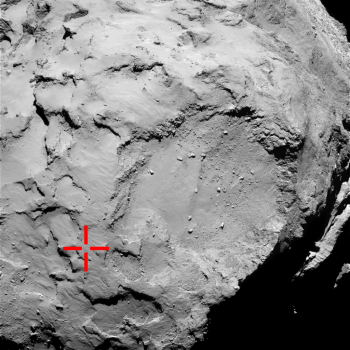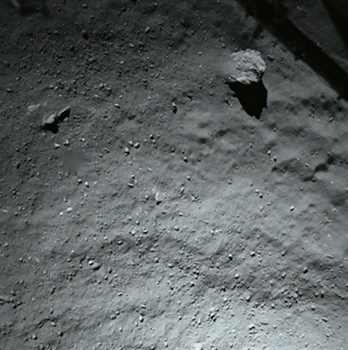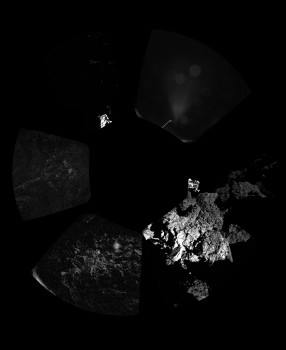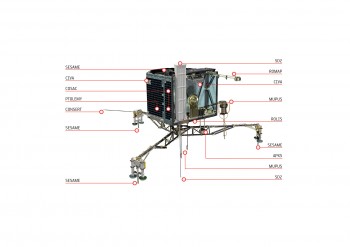This is an article from ESA’s Space Science Portal to summarise Philae’s landing so far. For a live summary and latest status update, watch the Google Hangout starting shortly at 13:00 GMT/14:00 CET.
After achieving touchdown on a comet for the first time in history, scientists and engineers are busy analysing this new world and the nature of the landing.
Touchdown was confirmed at ESA’s Space Operations Centre in Darmstadt, Germany at 16:03 GMT/17:03 CET on 12 November.
Since then, scientists, flight dynamics specialists and engineers from ESA, the Lander Control Centre in Cologne, Germany, and the Philae Science, Operations and Navigation Centre in Toulouse, France have been studying the first data returned from the lander.
These revealed the astonishing conclusion that the lander did not just touch down on Comet 67P/Churyumov–Gerasimenko once, but three times.

The location of Philae’s first touchdown on the surface of Comet 67P/C-G. Credits: ESA/Rosetta/MPS for OSIRIS Team MPS/UPD/LAM/IAA/SSO/INTA/UPM/DASP/IDA
The harpoons did not fire and Philae appeared to be rotating after the first touchdown, which indicated that it had lifted from the surface again.
Stephan Ulamec, Philae manager at the DLR German Aerospace Center, reported that it touched the surface at 15:34, 17:25 and 17:32 GMT (comet time – it takes over 28 minutes for the signal to reach Earth, via Rosetta). The information was provided by several of the scientific instruments, including the ROMAP magnetic field analyser, the MUPUS thermal mapper, and the sensors in the landing gear that were pushed in on the first impact.
The first touchdown was inside the predicted landing ellipse, confirmed using the lander’s downwards-looking ROLIS descent camera in combination with the orbiter’s OSIRIS images to match features.
But then the lander lifted from the surface again – for 1 hour 50 minutes. During that time, it travelled about 1 km at a speed of 38 cm/s. It then made a smaller second hop, travelling at about 3 cm/s, and landing in its final resting place seven minutes later.
The touchdown signal generated on first touchdown induced the instruments to ‘think’ that Philae had landed, triggering the next sequence of experiments. Now those data are being used to interpret the bounces.
Preliminary data from the CONSERT experiment suggest that Philae could have travelled closer to the large depression known as Site B, perhaps sitting on its rim. High-resolution orbiter images, some of which are still stored on Rosetta, have yet to confirm the location.
The lander remains unanchored to the surface at an as yet undetermined orientation. The science instruments are running and are delivering images and data, helping the team to learn more about the final landing site.
The descent camera revealed that the surface is covered by dust and debris ranging from millimetre to metre sizes. Meanwhile, Philae’s CIVA camera returned a panoramic image that on first impressions suggests the lander is close to a rocky wall, and perhaps has one of its three feet in open space.
After discussions as to whether to activate those science instruments that may cause the position of Philae to shift, MUPUS and APXS have both been deployed.
The primary battery enabling the core science goals of the lander may run out some time in the next 24 hours. As for the secondary battery, charged by solar panels on Philae, with only 1.5 hours of sunlight available to the lander each day, there is an impact on the energy budget to conduct science for a longer period of time. The original landing site offered nearly seven hours of illumination per 12.4 hour comet day.












Discussion: 41 comments
Times are either UTC (the correct naming for GMT) or comet time but cant be both. It probably means UTC as estimated by Philae or Rosetta instruments, but its still UTC time.
This is UTC, measured at the comet. The on-board clock was synchronized at launch, and for some reason UTC definition does not state where it is measured – so this is still UTC, although it is more properly called “on-board time”. You have to add the light travel time to get Earth time, in UTC scale.
Ahhh, timing in the solar system… 🙂
UTC is defined on the earth geoid, but its not the point here, you can sync to UTC wherever you want, even at half a billion km if you have the proper mean to do so.
Assuming the onboard clock is synchronized to UTC at one point and the onboard clock is perfectly stable (which can be valid at the 1s accuracy level) the time of the event is in UTC, no matter where it is measured. The 28 mn delay is just a delay, between the event itself and its detection at a specific point in the solar system, but it is not part of the timestamp of the events in the vicinity of the comet.
Now there are some relativistic (both special and general) effects that have affected the onboard clock, (and their impact can probably amount to something exceeding the 1 second range after 10 years ; it turns out as a hairy question). Thats why computations in the solar systems are generally made in an another time reference like TCB (see https://www.ucolick.org/~sla/leapsecs/timescales.html for a small walk in the delightful jungle of time scales and their specificities 🙂
Anyway, in the ‘lowres’ context of the blog, expressing times in UTC is the best compromise imho (but the 28 mn delay is not part of the timing problem).
This is a very good sumary about what was said yesterday by the team during the press conference.
I just have one question about one sentence : “suggests the lander is close to a rocky wall”. Perhaps I misunderstood as the conference press was given in English, but I thought one of the scientists explained that “rocky” was “improper” as this wall is probably not made of “rock” (as per definition we commonly use on earth).
Can one of you clarify this point ?
By the way, should I say once more FANTASTIC mission ? Yessssss, again and again, will never be enough 😀
Thanks.
Serge/
cant we capture an image from rosetta of possible landing site to find philae?
Question: I’m a sociologist so pretty different question…
I’m wondering about the mediatic coverage (that is huge and very pleasant!Congratulation for that too!)). As I think it’s unusual in the field of space studies, Is it complicated for researchers to cope with this, in terms of rythm and commitment ( for daily image/ report for example) ? Do it change, in a way or another, the usual ways they are working ?
Thanks you
First of all, congratulations to the whole ESA team for these fantastic achievements, what a great job you have done!
Just a question related to the phase when Philae was free-flying above the surface of the comet between first and last touchdown, has ROLIS taken pictures of the surface so that the precise trajectory can be reconstructed?
Thank you
If I’m not mistaken, Philae should be about the brightest object on the comet’s surface, so slightly underexposed (relatively to surface brightness) photo at the moment when it is in sunlight could reveal it even if it’s just one pixel big.
Can some part of Rosetta be used to reflect sunlight to Philae?
After the massive investment, to get Rosetta there and then to land robot Philae on the comet, one would think that guaranteed long term operation (a.k.a. nuclear battery) – whether in bitch dark or full sun – was THE ONLY OPTION. Other than that, a truly brilliant effort!!!
A “nuclear battery” would be too heavy to have made the trip.
Nuclear batteries are heavy and more difficult than solar cells (if your not inside a atmosfere like mars with all it’s dust storms). So, i think it’s a weight and size issue. To get the same electricity you need mutch more room and weight than with the normal solar cells. There just having bad luck to land in the shade. First landing would be a perfect spot. 3 system’s have failed to keep it there (Engine, drills and the harpoon system). So, normally this would not be a problem. But i must say, a bigger primary battery would be better next time 😉
if there is a next time
Indeed, sending an highly explodable nuclear load on a rocket is a brilliant idee, why did they not thinked about it?
By the way, a 1 Billion euros budget over 10 years is 500 time less than french education budget over the same period. So not that much. And not a massive investment at all.
Keep going ESA!
An April 1999 story in Nuclear News has a summary of RTG use on 26 U.S. space missions:
https://www3.ans.org/pubs/magazines/nn/pdfs/1999-4-2.pdf
10 years ago, those batteries had been ruled illegal – luddites thought they represented nuclear threats
Agree. Voyagers are still alive. But, is there really (however small) chance that the plutonium capsule from comet lander (if used) could one day get to the Earth orbit and enter the atmosphere? Then I would be cautious too.
The lander weighs around 100kg, mostly science and batteries. In order to perform the same science with a RTG, everything would have to be scaled way up to handle all that mass. It simply couldn’t have been done with the same order of magnitude budget.
I believe that it’s due to politcal reasons that there is no radioisotope thermoelectric generator on Philae. A RTG requires plutonium. There lies the problem I believe.
I believe it was said in a video provided by ESA that orbiting around the comet is achieved by changing the speed of Rosetta in relation to the speed of the comet, which means that it’s not a natural orbiting movement (they actually consume energy/ fuel to orbit!) so why didn’t Rosetta just stayed at it’s exact position till all the data were downloaded/ uploaded to/ from Philae before its batteries goes flat?!!
This done was more heroic in science and as humanly possible; the landing on the Moon.
Uncertain of the composition of this comet or any comet to affix itself or not. The accomplishment here is:
ESA Touchdown.! YES.!!
What’s the take-home lesson for the next mission – longer, lighter, more compliant legs? In hindsight there seems little reason for them to work as supporting legs for Earth gravity.
Perhaps something that could have been extruded like a large web while the lander spun after separation might have worked better.
more likely than finding Philae’s location, would be, i suppose, finding impact site no.2, given it is in the open field: with a bit of luck the surface bears some trace of the impact. Then Philae should be found close by? needs some good images and software.
Very ‘ancient egyptian’ to stick the heroes in a tomb by the way..
I was wondering the same, why didnt they put a nuclear battery on the lander isntead of relying on the sun. Seems it would have been a good idea considering the distance and cost involved.
Well, the answer is simple and complex at the same time… As Stephan Ulamec explained, at the time the Rosetta project came to fruition, Europe did not developped nor produced Radioisotope Thermal Generators (RTG) as the US (or USSR) did for some space applications. When the first project was eleborate as a NASA/ESA cooperative effort in the 80’s (missions NASA/CRAF and ESA/CNSR), NASA should have provided an RTG generator for both probes which had to share a common platform, but when NASA decided to cancel its CRAFT mission due to budgetary constraints, ESA decided to go alone and developped a purely european project which later became Rosetta (including a lander). As Europe did not possesed the RTG technology and was not inclined to develop one (cost, potential environmental problems in case of launch failure due to radioisotope elements, etc.), the simplest and cheapest way was to adopt the well known photovoltaic energy and onboard batteries technology as main source of power onboard the probes, with the limitations it would implied… 20 years later!
It does not appear that this comet is a dirty snowball. I’m eager to see the results of the data collected. I’m leaning towards the Electric Universe model. This body obviously has capacitance as is demonstrated by the “song”. The ejections do not seem to be caused by solar wind or heat at this distance from the sun.
I’ve heard mention of the plasma field surrounding the comet and would like to hear more. Could the comet be reacting to the electrical current sheets and cosmic waves of energy in deep space to cause these ejections? I can’t wait for more information! Congratulations ESA!
I understand that Philae will go dead soon as the small amount of sunlight it now gets is not enough to keep the battery charged. As the comet gets closer to the sun, however, will the increased intensity of light revive Philae?
RPC-Mag and ROMAP (magnetometers onboard the orbiter and the lander respectively) magnetic field measurements showing the separation/deployment/touchdowns of Philae:
https://www.igep.tu-bs.de/forschung/weltraumphysik/projekte/rosetta/comet_en.html
Nuclear battery!? Have you been watching too much Star Trek?
But to the team, great job! Yes it would be good if we were sure it’s up the right way or where you put it, but the achievement is great anyway and with a load of 10 year old equipment on board too!
Nuclear battery = RTG (Radioisotope Thermoelectric Generator) which is a technology used since a long time ago by some US and soviet/russian probes, but not european ones (see above).
so true and amazing
A TRULY BRILLIANT EFFORT and an ENORMOUS SUCCESS even if there is not another single piece of data or photo obtained. Everyone associated with the project should be proud.and you should absolutely be commended by the public who should recognize that this is yet one more GIANT STEP FOR MANKIND. You guys totally ROCK!!!
About ‘rocky’ material; the *average* density of 67P is 0.4 g cm^-3 (0.08 Earth’s) and its gravity is about 10^-4 Earth’s so the average composition has been compared to fluffy snow and cigarette ash, most dense to least dense respectively.
I know hindsight is a wonderful thing but I think the lack of an nuclear radioisotope for auxiliary power was a oversight, also due to the low gravity, perhaps some other form of anchoring would have been better rather than penetration, pressure differentiation or an adhesive. I’m not an expert, far from it, just an interested fan of space exploration.
I hope this mission is not a waste of time, good luck to all involved!
The quest for knowledge and scientific advancement is never, ever a waste of time. It’s the middle of the night and I am illuminated by a lightbulb powered by electricity that yet another scientist had the vision to experiment and create. In no way should this mission be considered a waste. Scientific discovery often leads to advancement far beyond its original purpose.
Further to Bill’s explanation about “nuclear batteries”, there is a useful article in April 1999 Nuclear News about 26 “U.S. space missions using radioisotope power systems” – so, 5 years before Rosetta’s launch. The sample RTG is 113cm long, with a 42.7cm diameter and a weight of 56.2kg.
https://www3.ans.org/pubs/magazines/nn/pdfs/1999-4-2.pdf
If Philae had a horizontal speed of 38 cm/s, wouldn’t it have traveled about 2500 m after 1 hour and 50 minutes instead of 1 km?
this is a cool subject to study
I think they spent to much money on the rosetta trip. They spent 1.86 billion *euros* i believe
yah